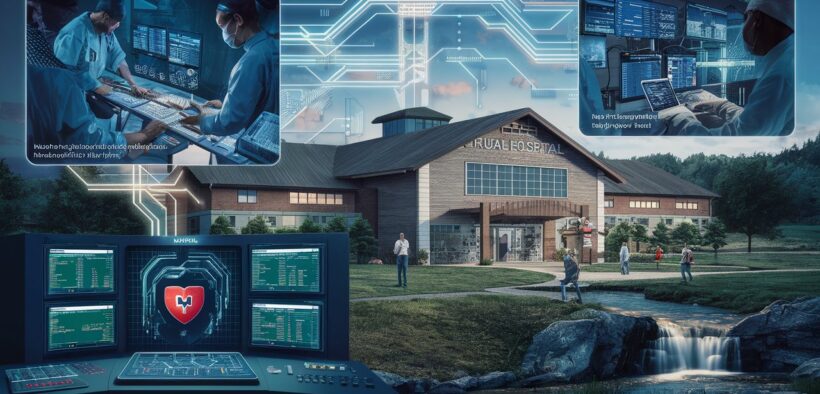American Rural Hospital Cybersecurity: Tech Giants Step Up
Share

American rural hospital cybersecurity is a race against time. These vital healthcare institutions, serving in remote communities, are facing a growing wave of cyberattacks. With limited resources and outdated systems, they are often easy targets for hackers. However, a recent collaboration between the White House and tech giants like Microsoft and Google offers a glimmer of hope. These companies are stepping up to provide free and low-cost cybersecurity solutions, aiming to bolster rural hospital defenses and safeguard patient data. There are several statistics available regarding ransomware attacks in the healthcare sector specifically in America, and globally.
Sharp Increase in Healthcare Ransomware Attacks
Healthcare organizations are in the crosshairs of cybercriminals. Rubrik’s findings reveal a shocking disparity – ransomware attacks inflict nearly five times the damage on healthcare data compared to other industries. A staggering 20% of sensitive healthcare data is compromised by successful attacks, compared to just 6% in other sectors.
- Increase in Healthcare Ransomware Attacks: Ransomware attacks in the healthcare sector have seen a significant increase in recent years. Worldwide, these attacks nearly doubled from 214 claimed victims in 2022 to 389 in 2023, indicating a sharp rise in ransomware activity targeting healthcare organizations.
- Impact on Healthcare Organizations: Between 2016 and 2021, there were 374 documented ransomware attacks on healthcare organizations in the United States. These attacks affected the personal or protected health information (PHI) of at least 41,987,751 individuals. The number of attacks more than doubled from 43 in 2016 to 93 in 2021.
- Disruption of Healthcare Services: Nearly half of the ransomware attacks (44.4%) led to disruptions in healthcare delivery, with common consequences including electronic system downtime, cancellations of scheduled care, and ambulance diversions. Specifically, 41.7% of attacks resulted in electronic system downtime, 10.2% led to cancellations of scheduled care, and 4.3% required ambulance diversions.
- Public Exposure of Stolen Data: In 15.8% of ransomware attacks, the actors made some or all stolen PHI public, typically by posting it on dark web forums where the data were advertised for sale.
- Frequency and Extent of Ransomware Attacks: Surveyed healthcare institutions in the United States reported varying frequencies of ransomware attacks between 2020 and 2022. Approximately 26% of these institutions experienced six to ten ransomware attacks, while 24% experienced three to five attacks during the same period.
Ascension Health, the largest Catholic hospital chain in the United States, is facing disruption after a cyberattack. The attack has impacted hospital operations. These statistics underscore the critical threat that ransomware poses to the healthcare sector, affecting not only the security of patient data but also the overall delivery of healthcare services.
Microsoft and Google Are Collaborating to Combat Healthcare Ransomware Attacks
The White House is collaborating with tech giants Microsoft and Google to offer free and low-cost cybersecurity resources, services, and training to rural hospitals across America, according to Anne Neuberger, the deputy national security adviser for cyber and emerging tech. In a call with reporters on Sunday, Neuberger highlighted that cyberattacks targeting the U.S. have not only compromised Americans’ sensitive personal data but also disrupted access to critical medical services, including stroke diagnosis and emergency surgeries. “Disruptions have taken days, weeks, or even months to resolve before full access to healthcare services or payment systems was restored,” Neuberger stated.
The White House is taking a coordinated approach, partnering with industry leaders to address cybersecurity vulnerabilities in under-resourced rural healthcare providers. The new public-private partnerships that would support between 1,800 to 2,100 rural hospitals.
Microsoft Corp. announced a new cybersecurity program aimed at supporting hospitals that serve over 60 million people living in rural America.
- Will extend its program for nonprofits to provide grants and up to a 75% discount on security products for independent critical access and rural emergency hospitals.
- Will offer its advanced security suite at no cost for a year.
Google has committed to launch a pilot program with rural hospitals to develop a tailored package of security capabilities that meet their unique needs.
- Will provide endpoint security advice and funding to support software migration for rural hospitals and nonprofits at no cost.
- Plans to launch a pilot program tailored to the unique security needs of rural hospitals.
What are the 5 Main Cybersecurity Challenges Faced by American Rural Hospitals?
- Limited Resources: Rural hospitals typically operate on tight budgets, making it difficult to invest in robust cybersecurity solutions. Hiring dedicated IT security professionals or purchasing top-tier security software may be out of reach. This often leaves them relying on outdated systems with known vulnerabilities.
- Shortage of Cybersecurity Expertise: Finding qualified IT staff, let alone cybersecurity specialists, can be a major hurdle for rural hospitals. Their locations may not be attractive to experienced professionals, leaving them with staff who wear multiple hats and may not have the time or expertise to stay up-to-date on the latest cyber threats.
- Legacy Infrastructure: Many rural hospitals struggle to afford system upgrades. Outdated operating systems and software are more susceptible to cyberattacks, making them prime targets for hackers.
- Increased Reliance on Technology: The healthcare industry is rapidly adopting new technologies like electronic health records (EHR) and telemedicine. While these advancements improve care, they also create new attack vectors for cybercriminals to exploit.
- Heightened Risk of Ransomware Attacks: Ransomware attacks, where hackers encrypt data and demand a ransom for decryption, are a major threat to rural hospitals. Disruptions to critical systems can delay treatment, endanger patient lives, and cause significant financial losses. These hospitals may be seen as easier targets due to their perceived lower defenses.
These challenges combine to create a perfect storm for cyberattacks on rural hospitals.
Devastating Consequences of Cyberattacks on American Rural Hospitals
Cyberattacks on American rural hospitals go far beyond simply compromising patient data. These attacks can have a cascading effect, disrupting essential services, jeopardizing patient safety, and pushing already financially strained institutions to the brink. Here’s a closer look at the potential consequences:
- Disrupted Operations and Delayed Care
- Crippled Systems: Hospitals rely heavily on computerized systems for everything from scheduling appointments and managing patient records to administering medications and monitoring vital signs. A cyberattack can render these systems inoperable, leading to:
- Cancellation of surgeries and procedures due to inaccessible patient data or malfunctioning equipment.
- Delays in treatment as healthcare providers struggle to access patient information and medical history.
- Diversion of ambulances to further-away facilities if critical systems are down.
- Manual Workarounds: In the absence of functioning IT systems, hospitals are forced to resort to time-consuming and error-prone manual processes, further hindering patient care and increasing the risk of mistakes.
- Endangering Patient Safety
- Loss of Access to Patient Data: Cyberattacks that compromise patient records can delay diagnosis and treatment plans. Delayed access to critical medical information can have life-threatening consequences.
- Medical Equipment Malfunction: Hackers can potentially disrupt the functionality of medical devices like pacemakers or infusion pumps, putting patients at immediate risk.
- Erosion of Trust: A data breach can shatter patient trust in a rural hospital’s ability to safeguard personal information. This can lead to patients delaying or avoiding necessary care altogether.
- Financial Strain and Potential Closures
- Ransomware Payments: Many cyberattacks involve ransomware, where hackers encrypt data and demand a hefty ransom for decryption. Small rural hospitals may not have the financial resources to pay such demands, further crippling their operations.
- Recovery Costs: The cost of recovering from a cyberattack can be significant, encompassing data recovery, system restoration, credit monitoring for patients, and potential legal fees. These expenses can cripple already tight budgets and threaten the financial viability of a rural hospital.
- Increased Insurance Premiums: Cyberattacks can lead to higher cyber liability insurance premiums for rural hospitals, further straining their finances. In worst-case scenarios, repeated attacks can force a hospital to close its doors, leaving a community without vital healthcare services.
- Ripple Effect on the Community
- Loss of Jobs: A cyberattack that shuts down a rural hospital can lead to job losses for healthcare workers, further impacting the local economy.
- Limited Access to Care: The closure of a rural hospital creates a healthcare desert, forcing residents to travel long distances for essential services. This can be particularly problematic for vulnerable populations, such as the elderly or those with chronic conditions.
- Deteriorating Public Health: Limited access to healthcare can lead to an increase in preventable illnesses and delayed diagnoses in rural communities.
The reports reveal that the Ransomware attacks on healthcare organizations surged by nearly 130% in 2023. The National Rural Health Association (NRHA) and the American Hospital Association (AHA) are advocating for government support to bolster cybersecurity in rural hospitals, potentially through grants for hardware and software upgrades and training programs for staff. Securing America’s rural hospitals against future ransomware attacks hinges on increased cybersecurity funding from Congress. As the recent Cyberspace Solarium Commission 2.0 report highlights, this funding is the critical line that will determine the fate of these vital healthcare providers.


